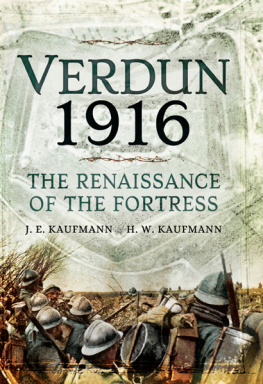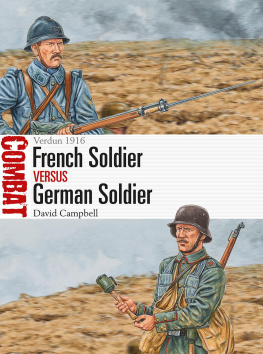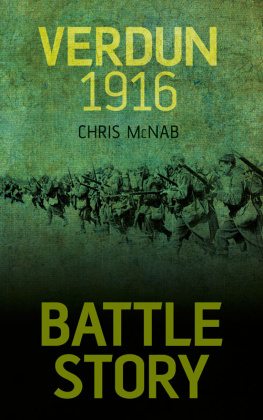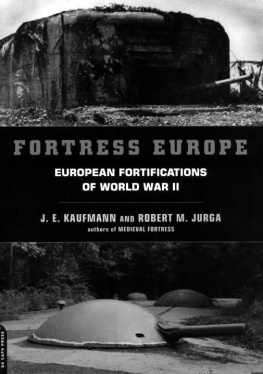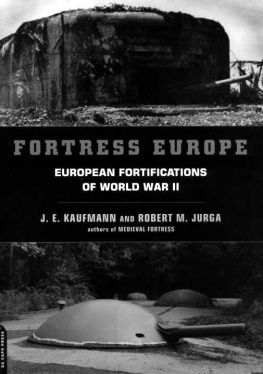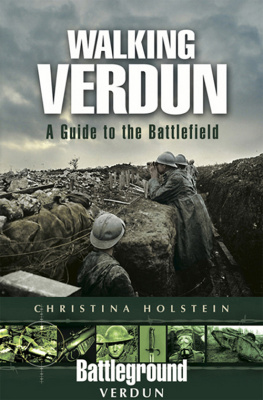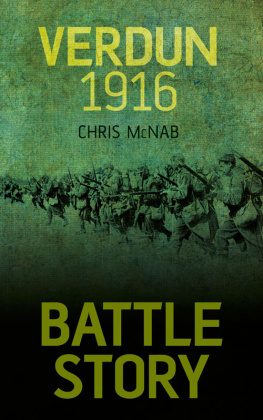First published in Great Britain in 2016 by
Pen & Sword Military
an imprint of
Pen & Sword Books Ltd
47 Church Street
Barnsley
South Yorkshire
S70 2AS
Copyright J.E. Kaufmann and H.W. Kaufmann 2016
ISBN: 978 1 47382 702 8
PDF ISBN: 978 1 47387 519 7
EPUB ISBN: 978 1 47387 518 0
PRC ISBN: 978 1 47387 517 3
The right of J.E. Kaufmann and H.W. Kaufmann to be identified as the Authors of this Work has been asserted by them in accordance with the Copyright, Designs and Patents Act 1988.
A CIP catalogue record for this book is available from the British Library
All rights reserved. No part of this book may be reproduced or transmitted in any form or by any means, electronic or mechanical including photocopying, recording or by any information storage and retrieval system, without permission from the Publisher in writing.
Typeset in Ehrhardt by
Mac Style Ltd, Bridlington, East Yorkshire
Printed and bound in the UK by CPI Group (UK) Ltd, Croydon, CRO 4YY
Pen & Sword Books Ltd incorporates the imprints of Pen & Sword Archaeology, Atlas, Aviation, Battleground, Discovery, Family History, History, Maritime, Military, Naval, Politics, Railways, Select, Social History, Transport, True Crime, and Claymore Press, Frontline Books, Leo Cooper, Praetorian Press, Remember When, Seaforth Publishing and Wharncliffe.
For a complete list of Pen & Sword titles please contact
PEN & SWORD BOOKS LIMITED
47 Church Street, Barnsley, South Yorkshire, S70 2AS, England
E-mail:
Website: www.pen-and-sword.co.uk
Contents
Acknowledgements
We would like to thank the following people for their help with this project: Bernard Bour and Patrick Corbon on French army tactics; Clayton Donnell for use of photos and loan of books; Christine Holstein for additional details on the battle; Tom Idzikowski for information on the Russian forts; Patrice Lang for information on the French army; Bernard Lowry for use of photos and other items; Marcus Massing for information about Verduns fortifications; Frank Philippart for use of photos and information; Marc Romanch for photos from the archives and information on artillery; Lee Unterborn for Internet searches; General David Zabecki for information on artillery. In addition, we thank the members of SiteO who helped us and hopefully have not forgotten anyone. Also, we would like to thank our editor, Rupert Harding, for tolerating the delay with the project and helping with contacts.
Note to Reader
In the text, all German and Austrian units are italicized to avoid confusion. Like most books of this size, the number of illustrations has been limited. It is strongly recommended that the reader use additional maps and plans that may be found in other books such as the volume West Point Atlas of Military History related to the First World War. There are also numerous Internet sites with good campaign and battle maps. The reader can find additional plans and illustrations of the French forts at Verdun and the battlefield in relatively inexpensive books such as Verdun 1916 by William Martin (Osprey), The Fortifications of Verdun 18741917 by Clayton Donnell (Osprey) and Fort Douaumont and Fort Vaux by Christina Holstein (Pen & Sword). Some older books found in many libraries, including Ptains Verdun, include detailed maps.
Preface
Nothing except a battle lost can be half as melancholy as a battle won
The Duke of Wellington at Waterloo, June 1815
Since the Battle of Verdun, a hundred years ago, an extraordinary number of books has been written on this long and gruesome engagement. The accounts cover many different points of view of the battle, relate individual experiences or present the conflict in a detached way disregarding the terrible experiences the soldiers endured. The last approach was particularly favoured by some of the generals who sat far behind the lines, moving their units like the pieces of a chess game. Although the numbers presented are shocking enough, they alone cannot give the proper perspective on a battle that is best described as hell on earth. To get an accurate picture of how Verdun brought together the horrors of combat, it would be advisable to read individual accounts and even some good historical fiction.
In the present volume, we have chosen to take the more objective approach, without, however, leaving out the horrifying aspects of this engagement. We examine the background, strategy and events of this great battle, although this has already been done. Not all historians will agree or draw the same conclusions. Primary sources, just like secondary ones, whether they come from individual accounts or official documents, must be subject to scrutiny and are not necessarily reliable. The contents of key primary sources such as reports, official documents, individual accounts and especially newspapers are not always dependable since they are often written with the intent of twisting the truth or bending it to the authors point of view. They may glorify an event, cover up mistakes or be written by someone with a limited view of events. The historian must take these and other sources, including secondary ones, and attempt to recreate the events as best he can. As a result, there are many different versions of a single battle or action.
One of the best examples of the difficulties historians face is the famous Schlieffen Plan, which shaped Germanys strategy in the First World War. In this case, the problem is that there is no actual and detailed pre-1914 documentation of the plan. After the war, General Wilhelm Grner shed some light on the plan in his memoirs in which he claimed that Helmuth von Moltke the Younger had modified the plan formulated by Alfred von Schlieffen. In Supplying War, military historian Martin van Creveld points out that, assuming that he and some other prominent figures are correct, the operation would have failed because Schlieffen had not taken into account the logistical needs of a modern army. He seemed to think that twentieth-century Likewise, General Falkenhayns reasoning for launching the Battle of Verdun may seem clear and obvious based mainly on his post-war writings, but it is likely that he was motivated by the need to justify his actions. After all, Erich von Falkenhayn was a rational and skilled general, yet, outwardly at least, his strategy at Verdun appears absurd. The Battle of Verdun and the naval Battle of Jutland were the climax as well as the anticlimax of the First World War and best exemplify the futility of the conflict. Here, when the two main antagonists met in 1916, their armies had finally reached the point of true modernization from their troops equipment to more massive and up-to-date weapons. Both sides also adjusted their tactics as the conflict degenerated into a gigantic battle of the trenches. Forts regained their importance after being considered obsolete after 1914.

Most of the weapons commonly associated with the First World War, except the tank, appeared on the battlefield at Verdun. Air warfare came of age over the skies of Verdun. Some of the best and worst generals on the Western Front got involved there as well. The battle in terms of win and loss devolved into a giant stalemate in which neither side achieved a major success but in which thousands of men were slaughtered. The Battle of Verdun did not dramatically change the course of the war, which continued to drag on in the West for over a year. Both sides would have been better off without the events that took place in 1916 on the Western Front.


